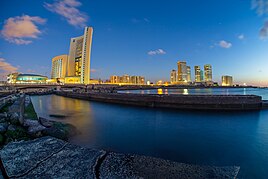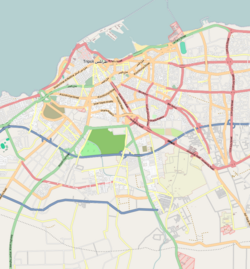
Back Tarabulus ACE Триполи ADY Tripoli Afrikaans ትሪፖሊ Amharic Tripoli (Libia) AN طرابلس Arabic طرابلس ARY طرابلس (ليبيا) ARZ Trípoli AST Tarabulus AVK
Tripoli
طرابلس | |
|---|---|
Clockwise from top: Tripoli panorama; Tripoli Central Business District; Arch of Marcus Aurelius; a street in Tripoli; Tripoli Beach Park; Martyrs' Square; and Red Castle Museum | |
|
| |
Location in Libya | |
| Coordinates: 32°53′14″N 13°11′29″E / 32.88722°N 13.19139°E | |
| Country | Libya |
| Region | Tripolitania |
| District | Tripoli District |
| First settled | 7th century BC |
| Founded by | Phoenicians |
| Government | |
| • Mayor (Tripoli Central) | Ibrahim Khalifi |
| • Governing body | Tripoli Local Council |
| Area | |
| 1,507 km2 (582 sq mi) | |
| Elevation | 81 m (266 ft) |
| Population (2023[1]) | |
| 1,183,000 [1] | |
| • Urban | 1,176,296 |
| • Metro | 1,192,436 |
| Time zone | UTC+2 (EET) |
| Area code | 21 |
| License Plate Code | 5 |
| Website | tlc.gov.ly (archived) |
Tripoli,[a] historically known as Tripoli-of-the-West,[b] is the capital and largest city of Libya, with a population of about 1.317 million people in 2021.[4] It is located in the northwest of Libya on the edge of the desert, on a point of rocky land projecting into the Mediterranean Sea and forming a bay. It includes the port of Tripoli and the country's largest commercial and manufacturing center. It is also the site of the University of Tripoli.
Tripoli was founded in the 7th century BC by the Phoenicians, who gave it the Libyco-Berber name Oyat (Punic: 𐤅𐤉𐤏𐤕, romanized: Wyʿt),[5][6] before passing into the hands of the Greek rulers of Cyrenaica as Oea (Ancient Greek: Ὀία, romanized: Oía).[7] Due to the city's long history, there are many sites of archeological significance in Tripoli. Tripoli may also refer to the sha'biyah (top-level administrative division in the Libyan system), the Tripoli District.
- ^ a b "Libya". 6 November 2023.
- ^ Jones, Daniel (2003) [1917], Peter Roach; James Hartmann; Jane Setter (eds.), English Pronouncing Dictionary, Cambridge University Press, ISBN 3-12-539683-2
- ^ "Tripoli - History, Geography, & Facts". Encyclopedia Britannica. 26 March 2020. Retrieved 30 September 2022., Van Donzel, E.J. (1994). Islamic Desk Reference. E.J. Brill. ISBN 978-90-04-09738-4. Retrieved 30 September 2022., Great Britain. Admiralty (1920). A Handbook of Libya. I.D. 1162. H.M. Stationery Office. p. 134.
- ^ "Major Urban Areas – Population". bsc.ly/demog_statist. Central Intelligence Agency. Archived from the original on 9 January 2019. Alt URL
- ^ Anthony R. Birley (2002). Septimus Severus. Routledge. p. 2. ISBN 978-1-13470746-1.
- ^ Mansour Ghaki (2015), "Toponymie et Onomastique Libyques: L'Apport de l'Écriture Punique/Néopunique", La Lingua nella Vita e la Vita della Lingua: Itinerari e Percorsi degli Studi Berberi, Studi Africanistici: Quaderni di Studi Berberi e Libico-Berberi (in French), vol. 4, Naples: Unior, pp. 65–71, ISBN 978-88-6719-125-3
- ^ Daniel J. Hopkins (1997). Merriam-Webster's Geographical Dictionary (Index). Merriam-Webster. ISBN 0-87779-546-0.
Cite error: There are <ref group=lower-alpha> tags or {{efn}} templates on this page, but the references will not show without a {{reflist|group=lower-alpha}} template or {{notelist}} template (see the help page).












